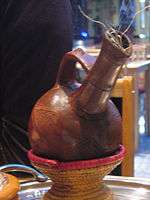Jebena

The jebena (Amharic: ጀበና? ǧäbäna), is a container used to brew coffee in the Ethiopian and Eritrean traditional coffee ceremony.
Overview


The jebena is usually made of clay and has a neck and pouring spout, and a handle where the neck connects with the base. The jebenas used in Ethiopia commonly have a spout, whereas those utilized in Eritrea usually do not.
Typically, when the coffee boils up through the jebena's neck, it is poured in and out of another container to cool it. The liquid is then poured back into the jebena until it bubbles up. To pour the coffee from the jebena a filter made from horsehair or other material is placed in the spout of the jebena to prevent the grounds from escaping. In Ethiopia, a small pottery cup called a sini or finjal is used to contain the coffee poured from the jebena.[1]
In Ethiopia they use a slightly different variation, theirs having a separate spout lower on the pot for pouring out the coffee. In Eritrea the jebena has only one spout at the top where they pour in the water and grinds and pour out the coffee.[2] There is a small restaurant in Ethiopia made in an image of an Ethiopian jebena figure.[3][4]
See also
 Coffee portal
Coffee portal
References
- ↑ "Ethiopian Coffee Ceremony: Jebena and Cini". ethiopianrestaurant.com. Archived from the original on February 8, 2014. Retrieved February 11, 2015.
- ↑ http://ineedcoffee.com/coffee-cultures-eritrea-and-ethiopia/
- ↑ "Restaurants in Ethiopia: Addis Ababa". ethiopianrestaurant.com. Archived from the original on February 8, 2014. Retrieved February 11, 2015.
- ↑ "Coffee House (Jebene bet) at the Crown Hotel, Addis Ababa". crownhoteladdis.com. Retrieved February 11, 2015.